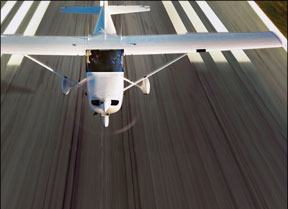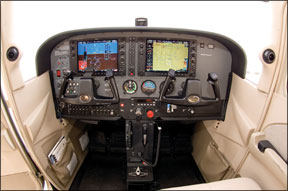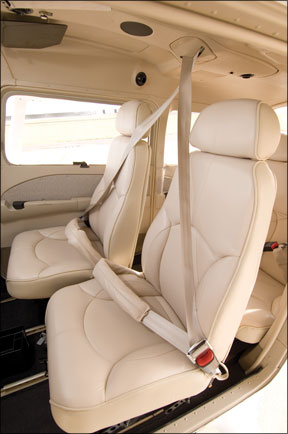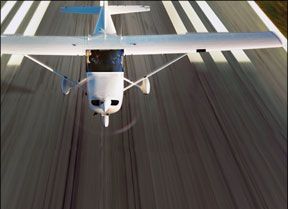In the world of light airplane manufacturing, Cessna has figured out one thing better than any other single manufacturer: There’s a difference between people who talk about buying airplanes and people who actually buy them. The people who talk gave up the Cessna Skyhawk for dead when it was reintroduced in 1997; the people who buy made it the second best-selling single in 2006 behind the Cirrus SR22. It will occupy the same position when the 2007 sales figures are tallied. Not bad for an airframe conceived in 1956 and still selling against the cutting-edge best from Cirrus, Diamond and others. Incredibly, Cessna isn’t done with the Skyhawk yet, having announced a Thielert-powered diesel version last fall at AOPA Expo in Hartford and, as of press time, it has dropped the 160-HP R-model from the lineup. Given Cessnas confidence in the 172, we wondered how the four variants of the Skyhawk-two versions of the 180-HP gas model and two versions of the new diesel-stack up against each other and against an older Hawk. When Cessna returned to single-engine piston production in 1996 for the 1997 model year, the task wasnt as simple as Cessna or buyers may have assumed. The 50-year-old design had to be recertified under new standards, to meet modern buyer expectations, ergonomic, style and maintenance upgrades were required and the new versions would also need a new engine. Although it planned to reintroduce the 182 and 206 too, Cessna initially focused on the Skyhawk alone. At $135,000 retail, the price was about twice as much as the last new Skyhawk to emerge from Wichita, the 1986 172P. At Oshkosh in 1996, there was open skepticism that Cessna would be able to justify the price increase after a decade of absence from the market. What the skeptics didnt get-but Cessna did-was that there wasnt a comparable airplane out there, not from Piper, nor Diamond, nor Cirrus nor anyone else. If you wanted a new Cessna, this was it. Second, inflation and 10 years of litigation horror stories had ingrained in buyers minds that airplanes would never be cheap because of insurance costs, not just for the manufacturer, but for everyone else who had so much as a nut, bolt or wire on the airplane. And when it emerged, the 172 was, well, nice. It wasnt terrifically special, but was a cut above the 172P. It had a clean metal panel, great upholstery with crashworthy seats, better seatbelts, modern interior plastics and the fuel-injected 180-HP Lycoming IO-370-L2A de-rated to 160 HP was a strong selling point.
Upscale Models
Compared to Cessnas 1978 piston heyday, the 172R didnt set the world afire sales wise, but it did we’ll enough. Whats axiomatic in cars is also true in airplanes: The basic model begets a higher-price, tarted-up version that yields more margin for the manufacturer and perceived greater value for the buyer-enter the Cessna 172S/Skyhawk SP.
Cessna had always had the full 180-HP model on a back burner, but who would buy a 160-HP airplane if they knew that the same engine would produce more horsepower in the same airframe? In essence, the reason for two models of the same airplane is pure marketing. When the initial excitement of the new 172 wore off, the model needed a nudge to keep the line moving. In 1998, the 172 SP appeared and is now Cessnas top-selling single in volume, if not dollars. (The Turbo Skylane is second, and the 172R and straight 182 tie for third.) The SP made full use of the Lycoming engine by allowing increased RPM from 2400 to 2700. Cessna accomplished this rather simply by using the McCauley 1A170E/JHA 7660 (76-inch length/60 pitch) rather than the R models 1C235/LFA7570 (75-inch/70 pitch) and adjusting the mags. Twenty more horses allowed Cessna to increase the gross weight to 2550 pound and change. (The model we flew had a ramp weight of 2557 pounds.) The R-model 172 has a gross-weight limit of 2450 pounds. The SPs advertised maximum useful load is 837 pounds versus 758 pounds for the R-model.
Other differences are few and minor. An autopilot is available in the SP, first the Bendix/King KAP140 and now the fully integrated Garmin GFC 700. The SP is (generally) distinguishable with its polished rather than painted spinner and most roll out the door with rearseat airbag shoulder harnesses, a $1625 option.
The base price for the 172R was recently raised from $219,500 to $234,500 and it will be available only through mid-2008 and only with the Garmin G1000. Going forward after that, only 180-HP gasoline models will be sold in two variants: The S-GA selling for $254,500 and the SP at $283,500.
With its 180-HP engine, the S is technically a different model than the R, but the two S models remaining in the line are essentially differentiated by options. The S is the old SP and is fully equipped with the GFC 700, XM-based datalink weather and leather seats. The S-GA is the stripped down model-G1000, but no autopilot and fabric seats. Both have air conditioning as a $28,100 option, along with TAWS, airbag seatbelts and other options.
Enter the Diesel
In the December 2007 issue of
Aviation Consumer, we offered a first look at the new Cessna 172 TD for turbocharged diesel. The version we flew and examined was a test article, so we have to reserve final judgment on the TD for a later date. Specs wise, Cessnas current numbers on the TD claim a maximum gross weight of 2552 pounds with a useful load of 744 pounds, which is comparable to the R-model 172, but about 93 pounds less than the S.Our report on Diamonds experience with diesels revealed that lack of engine

longevity and reliability has disappointed many owners, something Cessna says its aware of and will address. Cessna and Thielert are planning on a 2400-hour TBR (time between replacement) for the TD model. Whether the TD will be a strong seller in the U.S. remains to be seen. The diesel version will carry a price premium over the SP, selling for $269,500 in a GA version and $298,500 in a fully optioned version. Like the other models, it will be only Garmin G1000 equipped.
Performance
To gain a sense of how the airplanes compare, we flew all three models. In doing that, we noticed that the R-model prop kept the engine from turning to rated power and this is noticeable on takeoff and climb. A 172R, loaded with 758 pounds of people and stuff, will use 945 feet of runway and 1685 feet total to clear the standard 50-foot obstacle. It will climb to an optimal altitude of 8000 feet with an initial rate of 720 FPM and once there, it will cruise at about 122 knots at 80 percent power. It can climb to 13,500 feet but wont have much left at that altitude.
With a flatter pitch prop and additional 300 RPM, the S manages a 960-foot ground run and 1630 feet total to clear the 50-foot obstacle. It will climb to 8500 feet initially at 730 FPM and will cruise there at 124 knots on 75 percent power. Service ceiling is higher at 14,000 feet.
These are clearly marginal performance differences, considering the difference in price. We noted that the slower turning R engine burns considerably less fuel. Ranges are 580 miles for the R and 518 miles for the S. This extra 62 miles might make a difference at the end of a flight, considering the cruise speed difference is only 2 knots. The 35-minute difference wont mean much on a 550-mile trip if you have to stop for fuel.
Just for grins, we flew an older Hawk for a comparison. A 1967 172 with a 145-HP

engine carried 1275 pounds of useful load and cruised at 113 knots, with a range of 478 miles. That airplane was on the market at $30,000, or only about 13 percent of a new R-model and a mere 10 percent of the diesels price. Invest another $30,000 in the older airplanes paint, interior and avionics and you’ll have a nice, capable and clean airframe, but not one thats remotely like a new glass-panel Skyhawk.
This, more than anything, explains why used aircraft prices are now stable or declining. The older airplanes, while their performance offers an excellent value, are showing their age. Cosmetically and to a lesser degree mechanically, they show heavy wear. No amount of air freshener will make tired Royalite and years of neglect smell like new. And lets face it, the ability to work in the system is more important these days than performance and increasingly, that means a glass panel.
Comparing the old to the new, flying the old 172 and the factory fresh model revealed what we expected: The old airplane was sloppy and drafty, the new one was tight, aerodynamically and mechanically. The cabins in the new airplanes are dramatically quieter, almost night and day. Control response is typical Cessna conservative, but immediate and predictable-just whats wanted in a Cessna 172.
The starkest difference is in the interior. The new Cessna seats are better made, more comfortable and safer, so much so that for reasonable money, youre not going to duplicate that interior in an older airplane.
Last, the glass panel, which is now a standard feature in new airplanes. Buyers arent interested in steam gauges and we don’t blame them. Private owners and flight schools alike made the jump to this more expensive option, which is so popular that Cessna made it standard on
everything it sells, not just the Hawk. They also designed and instituted a training program for the G1000 system to bolster sales and help in the transition from steam gauges.Analysis
Why would anyone buy a new Skyhawk, anyway? It will still cost most of a quarter of a million bucks. Wouldnt it make sense to spend a little more and get a faster Diamond DA40 or perhaps an Archer or even a 182? Maybe. Or maybe not.
Flight schools buy 172s for the same reason they always have-flexibility, economy, ease-of-operation and maintainability. Schools make money on 172s, new or used. Private owners weve spoken to who have bought Skyhawks have done so because their performance needs are modest, they don’t fly every day or even every week and the Skyhawk has no bad habits to bite the pilot who falls to the dark side of the proficiency curve. Its a comfort-level thing and Cessna has that figured out, too. Cessna also has its name and reputation-70 years of experience, a worldwide comprehensive service network and one of the best safety records ever, although Diamond probably bests it, in our view.
The Cirrus SR20 is a strong contender in this market, but the Skyhawk outsells the SR20 by more than two to one, this despite the fact that the SR20s least expensive variant sells for $214,900 with a glass panel, compared to the 172R at $234,500. The SR20 is also nearly 30 knots faster than the Skyhawk.
But it isn’t a Skyhawk and thats exactly the point. So if you want a 172, which is the best value? If youre choosing between the -R, S-GA and the -S, a look at the performance numbers shows that the performance is so close as to hardly justify the considerable price difference. The S doesnt carry much more, its not much faster, it climbs only a little higher.
Digging deeper, the fact that an autopilot isn’t available on the soon-to-be-discontinued R, regardless of the avionics package, may be the dealmaker/breaker for many buyers. Or maybe its the leather seats that explain why the SP model has outsold the R model by about four to one.
The sleeper here is the diesel-powered 172 TD. Diamond has clearly shown that there’s worldwide interest in diesel powerplants for aircraft and despite serious complaints about maintenance and longevity, Diamonds diesel program is a qualified success. If Diamond can, Cessna can. Round two of diesel development will be powered by the new Centurion 2.0 from Thielert and we predict that if Cessna encounters any maintenance issues with this engine, it will bludgeon them to a pink pulp with its established service network. Cessna is more than big enough to hold Thielerts feet to the fire on this and we think they will.
That said, were reserving judgment on the TD until the production version is available and in the hands of owners so we can collect some feedback. We also plan to fly it again.
Meanwhile, if you want a new Skyhawk and an autopilot is a must, the 172S is the better choice, despite its higher invoice number. But if youre a 60-hour a year recreational pilot, you can save a bunch of money and still have a glass panel by foregoing the autopilot and the leather seats in favor of the S-GA model-the new version of the R. In our view, thats not a bad choice.
Jim Cavanagh is a freelance writer and pilot. He lives in Kingsville, Missouri. Hes a frequent contributor to
Aviation Consumer.

